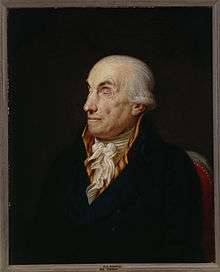Pfeffel family
The Pfeffel family (ennobled as von Pfeffel) is a German and Bavarian family originally from Neuburg an der Donau in Bavaria. Some family members were ennobled in Bavaria in the 19th century. The family's history was explored in the BBC series Who Do You Think You Are?.[1]
The family is descended from the watchman Johannes Pfeffel (1580–1634) of Neuburg an der Donau. His son Conrad Pfeffel (born 1605) was a tailor in Augsburg, and was the father of pastor in Freiburg im Breisgau Johann Conrad Pfeffel (1636–1701). The latter's son Johann Conrad Pfeffel (1682–1738) moved from Freiburg to nearby Colmar in Alsace, where he served as Stettmeister (mayor) for half a year in 1727. He was the father of the historian, lawyer and diplomat Christian Friedrich Pfeffel (later Pfeffel von Kriegelstein) (1726–1807). His son Christian Hubert Pfeffel von Krigenstein (1765–1834) served as the Envoy of the Kingdom of Bavaria to the United Kingdom and was raised to the rank of Freiherr (Baron) in his native Bavaria. He was the father of Baroness Ernestine von Pfeffel (1810-94), who married in 1839 Fyodor Tyutchev (one of the most famous Russian poets), and Freiherr Karl Maximilian Friedrich Hubert Pfeffel von Krigenstein (born 1811 in Dresden, died 1890 in Munich) who married Karoline von Rottenburg, a natural daughter of Prince Paul of Württemberg. A younger brother of Christian Friedrich Pfeffel von Kriegelstein was the writer Gottlieb Konrad Pfeffel (1736–1809).
Among the children of Karl Maximilian was Freiherr Christian Hubert Theodor Marie Karl von Pfeffel (born 1843 in Munich, died 1922), who married Hélène Arnous-Rivière. They were the parents of Marie-Louise von Pfeffel (1882–1944), the great-grandmother of Boris de Pfeffel Johnson, the British Prime Minister.
A mummified corpse of a woman buried in the Barfüsser Church in Basel, Switzerland, was identified in 2018, 43 years after the discovery, as Anna Catharina Bischoff (1719–1787), the mother-in-law of Christian Friedrich Pfeffel von Kriegelstein (1726–1807).
